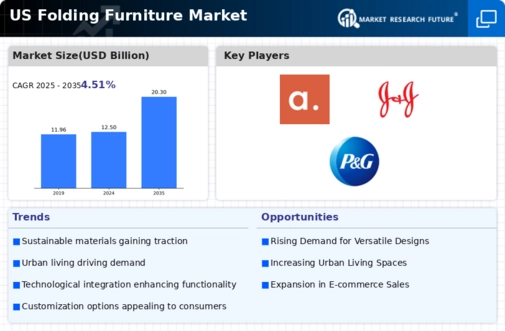Rising E-commerce Adoption
The rise of e-commerce in the United States has transformed the way consumers shop for furniture, including folding options. With the convenience of online shopping, consumers can easily compare products, read reviews, and make informed purchasing decisions from the comfort of their homes. Data shows that online furniture sales have increased by over 30% in recent years, with a significant portion attributed to folding furniture. This trend indicates that the folding furniture market is likely to benefit from enhanced visibility and accessibility through online platforms. Retailers are increasingly investing in digital marketing strategies to reach a broader audience, thereby expanding their customer base and driving sales in the folding furniture market.
Evolving Consumer Preferences
Consumer preferences in the United States are evolving, with a noticeable shift towards convenience and flexibility in furniture choices. The folding furniture market is experiencing growth as consumers increasingly prioritize products that offer adaptability to their lifestyles. Recent surveys indicate that around 65% of consumers prefer furniture that can be easily moved or reconfigured to suit different occasions, such as hosting guests or creating additional space for activities. This trend suggests that manufacturers must focus on creating lightweight, portable, and aesthetically pleasing folding furniture options. As a result, the folding furniture market is likely to see a surge in demand for innovative designs that align with these changing consumer preferences, ultimately driving market growth.
Urbanization and Space Constraints
The ongoing trend of urbanization in the United States has led to increased population density in metropolitan areas. As living spaces become smaller, the demand for space-saving solutions rises. This phenomenon significantly impacts the folding furniture market, as consumers seek versatile and compact furniture options that can be easily stored when not in use. According to recent data, approximately 80% of urban dwellers express a preference for multifunctional furniture that maximizes limited space. This shift in consumer behavior indicates a growing reliance on folding furniture as a practical solution for modern living environments. Consequently, manufacturers in the folding furniture market are likely to innovate and expand their product lines to cater to this emerging demand, thereby enhancing their market presence.
Increased Focus on Home Office Solutions
The shift towards remote work has prompted a surge in demand for home office solutions in the United States. As more individuals seek to create functional workspaces within their homes, the folding furniture market is positioned to capitalize on this trend. Many consumers are looking for flexible furniture that can easily transition from work to leisure. Recent studies suggest that nearly 50% of remote workers prefer furniture that can be adjusted or stored away when not in use. This growing need for adaptable home office solutions indicates a potential growth area for the folding furniture market, as manufacturers develop products that cater to the unique requirements of remote workers.
Sustainability and Eco-Friendly Materials
Sustainability has become a key consideration for consumers in the United States, influencing their purchasing decisions across various sectors, including furniture. The folding furniture market is likely to experience growth as consumers increasingly seek eco-friendly options made from sustainable materials. Recent reports indicate that approximately 70% of consumers are willing to pay a premium for furniture that is environmentally friendly. This trend suggests that manufacturers in the folding furniture market may need to prioritize sustainable practices in their production processes. By incorporating recycled materials and environmentally responsible manufacturing methods, companies can appeal to the growing segment of eco-conscious consumers, thereby enhancing their market competitiveness.














Leave a Comment